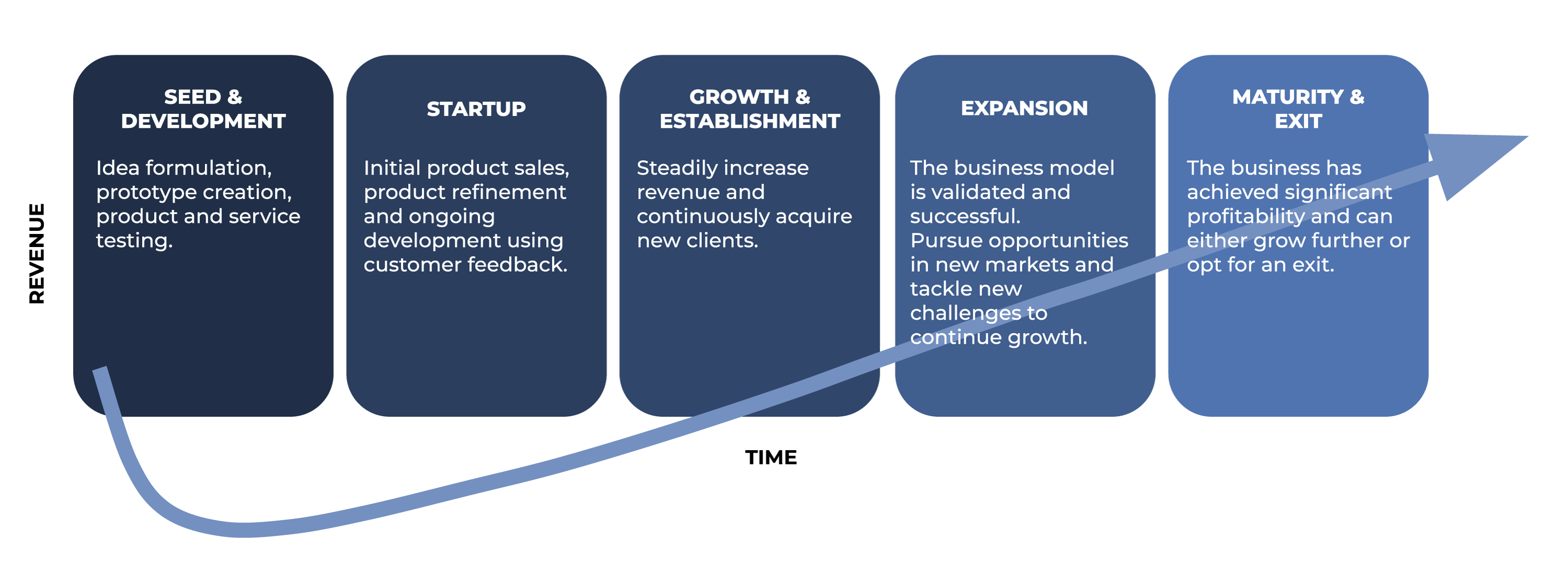- Home
- Resource Center
- Articles & Videos
- How Innovation Can Support Your Growth and Exit Strategy
28 May 2024
How Innovation Can Support Your Growth and Exit Strategy
In business, innovation is one of the most impactful ways to move your company forward. Whether you're trying to elevate your business to the next level with investment or considering a merger or acquisition, the path to achieving your goals is fundamentally linked to how well innovation is integrated into your operations.
From new technologies to business models, finding inventive ways to enhance your operations is not just beneficial but essential for companies seeking successful growth and exits. This article explores how creative solutions can be systematically integrated into your business model to prepare for a successful strategic evolution, whether it entails scaling up, merging, or preparing an exit.
Understanding Strategic Evolution
Strategic evolution in business means recognizing how creative ideas underpin every phase of a company's arc, from inception to growth to an eventual exit. It's about leveraging new concepts, technologies, and methodologies to continuously adapt and expand, ensuring the business stays relevant and competitive in a fast-changing market.

This process involves not only the creation of new products or services, but also embracing new ways of doing things that creates efficiencies, drives sustained growth, and increases the company's value. It starts by identifying unique market opportunities and continues by building a strong, recurring pipeline, scaling operations, leveraging emerging technologies like AI to improve and enhance service delivery, and using analytics for organization and evaluation of data leading to smarter decision-making.
This strategy and cycle of conscientious continuous improvement ensures business offerings remain relevant, market value is growing, and companies are positioned advantageously for the next steps in their evolution.
Enhance Your Strategic Blueprint
The impact of innovation on business operations is profound. It streamlines processes, improves efficiency, and enhances scalability — key elements for businesses aiming to grow or transition. Programmatic improvements and new business models or services can tap new markets and create new revenue streams, increasing a company's valuation and appeal in the eyes of potential acquirers or partners.
In the context of the localization industry, recognizing when these improvements are needed and successfully implementing them is crucial. By keeping abreast of technological advancements and shifting market trends, companies can stay competitive. Developing a culture that values thinking ahead, experimentation, and creativity ensures that a business is not just reacting to changes, but actively shaping its future for its strategic advantage.
Innovation often comes down to how your business creates value in an ever-evolving market. For investors, language service providers (LSPs), and language technology companies, ingenuity represents the key to unlocking growth and enhancing competitive advantage.
There are several approaches others have taken that you should carefully consider:
1. Align innovation with business goals: Connecting innovation to business objectives produces tangible outcomes. Successful companies treat innovation as an important and strategic function, aligning it with their mission and using it to drive their long-term vision.
2. Navigate the path of strategic transformation: Integrating innovation is a journey of strategic transformation. This entails not only adopting new technologies, but also promoting a culture that embraces change, experimentation, and learning from failure. It's about becoming an organization that is responsive to today’s market changes while also being able to anticipate and shape future trends.
3. Establish frameworks: Develop structured processes designed to identify, evaluate, shape, and implement original ideas. This could include dedicated innovation teams, idea submission portals, or regular brainstorming sessions for strategic thinking outside of the day-to-day business environment. By providing a framework, you can foster a more systematic approach to driving strategic evolution.
4. Build an ecosystem: The complexity of today's global market requires more than going at it alone; it necessitates developing an ecosystem. By actively participating in or building ecosystems, language service and language technology companies can collaborate with startups, academic institutions, and cross-industry partners to co-create value.
5. Cultivate a balanced approach: When pushing the boundaries of ideas and invention, it's important to take a balanced approach. This involves evaluating in a logical and systematic way the scalability, sustainability, and ROI of new initiatives. This might mean investing in technology that offers the most impact on operational efficiency and customer satisfaction, while also considering the long-term strategic fit and bottom-line impact.
6. Foster partnerships: Seek out strategic partnerships with industry leaders, technology providers, or complementary businesses. These collaborations can expose your organization to new ideas, best practices, and growth opportunities. By tapping into and leveraging external expertise and resources, you can accelerate your business growth.
Observations about Strategic Evolution
In the language services industry, innovation often manifests through strategic technological integration and creative business models. An example of this is a small language service provider that embraced and leveraged cloud computing to offer real-time translation services globally. By utilizing scalable cloud infrastructure, they were able to efficiently manage large volumes of translation requests, enhancing their operational flexibility and market reach. This approach not only improved service delivery but also significantly expanded their customer base across diverse industries.
Another example is a company that introduced a subscription-based model for their translation services, tailored specifically for tech startups needing a continuous supply chain of translation for their global operations. This model provided predictable costs for clients while ensuring steady revenue for the provider. It also allowed the service provider to align more closely with the dynamic needs of fast-growing companies, fostering long-term partnerships and deepening client engagement.
With the introduction of Large Language Models (LLMs) in 2023, the changes that AI will bring to the industry are still unfolding. In the years to come, we should expect more creative business models, M&A activity, and strategic exits as new and enterprising ways of working are invented and commercialized.
When an Exit Strategy Isn’t the End Game
Too often, the term “exit strategy” conjures up images of selling off and moving on, but the reality is often more complex. While expansion or exit might seem like the only choices, a range of options are available. Here are a few real-world examples from a variety of businesses, including the language services and technology industry, that the Group-Q team has participated in.
● Expansion through subsidiary creation: A European company strategically established a wholly-owned subsidiary to qualify for US government contracts and expand its core business, illustrating how geographical expansion and targeting new markets can be an important part of a broader growth strategy.
● Strategic acquisition for market penetration: An acquisition in the US helped a European company meet critical criteria to contract with a global enterprise, showing how targeted acquisitions can serve specific market growth goals.
● Joint ventures for market expansion: A European family-owned business accomplished its expansion goals by forming a joint venture with a small US entity. This move leveraged the in-country company's technical knowledge and market insights to create a new entity that could operate successfully in the new market for mutual benefit.
● Strategic alliances for shared growth: When two European companies formed a strategic alliance with a US company, they chose a path that allowed them to invest without assuming full ownership. This strategy facilitated mutual growth and a stronger presence in their respective markets, proving strategic alliances can be as robust as full acquisitions.
● Management buy-outs for seamless transition: In a particularly personal exit, an executive purchased control of a US company from its retiring owner with investment assistance from the company’s European customer. This real-life example underscores the potential of internal transitions to preserve the company’s legacy, brand, and stability while leveraging external resources for future growth.
● Employee ownership to foster investment: A US business owner decided to transfer shares of the company’s stock to long-serving employees. This helped transform the employees into stakeholders to better align their interests with the company’s success and ensured a deeper commitment to the business's future.
Shape the Future of Your Business
As a senior industry leader, your vision of your company not only defines its current trajectory, but also shapes its future. Preparing for a strategic evolution does not signal the end, rather, it is a proactive step toward realizing your vision on a larger scale, whether through investment, merger, acquisition, or otherwise.
Innovation is more than an enhancement to your business operations; it is essential for creating a competitive edge and boosting your company’s market value. It’s about strategically integrating new technologies, business models, and partnerships to make your company not just an industry participant, but an industry leader. This integration should be deliberate, systematic, and aligned with your long-term business goals, ensuring every step forward is a step toward greater success.
By fostering a culture of innovation and continuous improvement, your business can achieve sustainable growth and attract the right investors or partners. This is how you secure a legacy in a rapidly growing market. Ultimately, the choices you make today will define the future of your company. Embrace the opportunity to shape a future that reflects your ambitions and the potential of your team. Don’t just reach for success, proactively redefine it.

Diane McAveeney
Diane McAveeney, CEO and Founder of Group-Q, is a well-known expert in sales optimization and business transformation. Group-Q is a go-to-market partner who can accelerate global expansion, optimize localization strategies, and support every stage of your growth and exit strategy. https://group-q.com/


